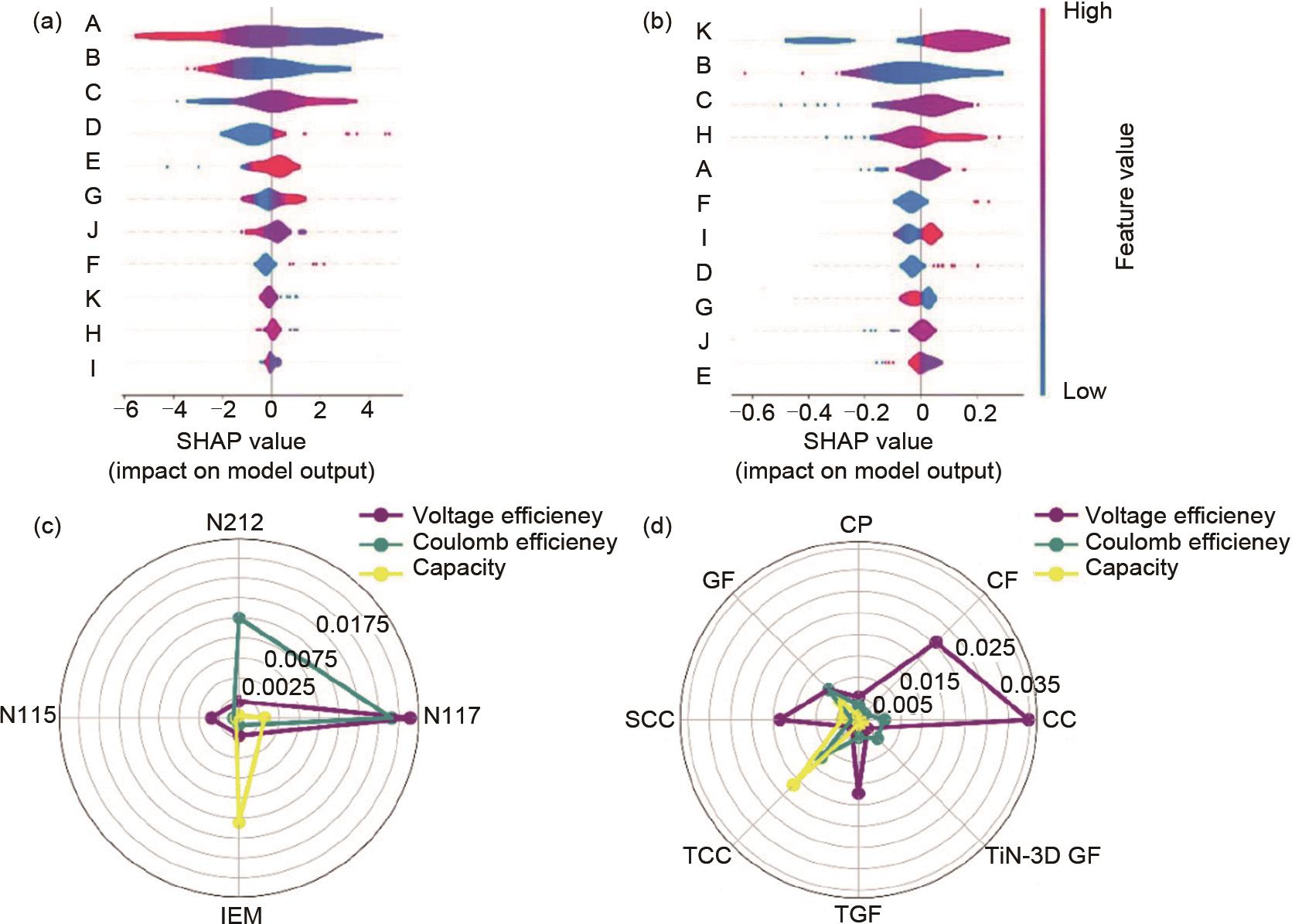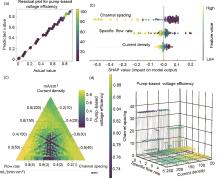Energy Storage Science and Technology ›› 2024, Vol. 13 ›› Issue (9): 2871-2883.doi: 10.19799/j.cnki.2095-4239.2024.0709
Previous Articles Next Articles
Ziyu LIU1,3( ), Zekun JIANG1(
), Zekun JIANG1( ), Wei QIU1, Quan XU1, Yingchun NIU1,2(
), Wei QIU1, Quan XU1, Yingchun NIU1,2( ), Chunming XU1, Tianhang ZHOU1,2(
), Chunming XU1, Tianhang ZHOU1,2( )
)
Received:2024-07-31
Revised:2024-08-22
Online:2024-09-28
Published:2024-09-20
Contact:
Yingchun NIU, Tianhang ZHOU
E-mail:liuziyu0329@126.com;3090201807@qq.com;niuyc@cup.edu.cn;zhouth@cup.edu.cn
CLC Number:
Ziyu LIU, Zekun JIANG, Wei QIU, Quan XU, Yingchun NIU, Chunming XU, Tianhang ZHOU. Application of artificial intelligence in long-duration redox flow batteries storage systems[J]. Energy Storage Science and Technology, 2024, 13(9): 2871-2883.
Table 2
Accuracy evaluation of the models for the test subset[3]"
| 模型 | 电压效率 | 库仑效率 | 容量 | ||||||
|---|---|---|---|---|---|---|---|---|---|
| R2 | MSE | MAE | R2 | MSE | MAE | R2 | MSE | MAE | |
| Linear Regression | 0.8843 | 2.9735 | 1.3319 | 0.4061 | 1.1773 | 0.8998 | 0.8520 | 0.0321 | 0.1495 |
| Extra Trees | 0.9764 | 0.5179 | 0.5450 | 0.7989 | 0.4382 | 0.5060 | 0.9890 | 0.0023 | 0.0318 |
| Random Forest | 0.9608 | 0.8015 | 0.6477 | 0.8642 | 0.2691 | 0.4275 | 0.9854 | 0.0026 | 0.0342 |
| Gradient Boosting | 0.9859 | 0.3608 | 0.4309 | 0.9212 | 0.1522 | 0.2924 | 0.9940 | 0.0011 | 0.0235 |

Fig. 3
The SHAP scores for the features of the GB model for (a) voltage efficiency and (b) capacity; Absolute average values of feature SHAP values of (c) the membrane and (d) electrode types versus voltage efficiency, coulombic efficiency, and capacity, respectively. A: current density, B: cycle number, C: electrode type, D: catalyst -Bi3+, E: electrolyte -H+, F: catalyst -In3+, G: membrane, H: electrolyte -Cr3+, I: flow rate, J: electrolyte -Fe2+, and K: electrode size[3]"


Fig. 4
Residual plots of GB model for (a) pump-based voltage efficiency; SHAP analysis for (b) pumped-based voltage efficiency; (c) 2D and (d) 3D triangular plot of variation in pump-based voltage efficiency vs normalized values of current density (mA/cm2), specific flow rate [mL/(min·cm2)] and channel spacing (mm)[25]"

| 1 | SHOAIB M, VALLAYIL P, JAISWAL N, et al. Advances in redox flow batteries-A comprehensive review on inorganic and organic electrolytes and engineering perspectives[J]. Advanced Energy Materials, 2024, 14(32): 2400721. DOI: 10.1002/aenm.202400721. |
| 2 | YI Y P, CHANG L, WU B X, et al. Life cycle assessment of energy storage technologies for new power systems under dual-carbon target: A review[J]. Energy Technology, 2024, 12(5): 2301129. DOI: 10.1002/ente.202301129. |
| 3 | NIU Y C, HEYDARI A, QIU W, et al. Machine learning-enabled performance prediction and optimization for iron-chromium redox flow batteries[J]. Nanoscale, 2024, 16(8): 3994-4003. DOI: 10.1039/d3nr06578b. |
| 4 | LI G D, CHEN W, ZHANG H, et al. Membrane-free Zn/MnO2 flow battery for large-scale energy storage[J]. Advanced Energy Materials, 2020, 10(9): 1902085. DOI: 10.1002/aenm.201902085. |
| 5 | XU Q, WANG S Y, XU C M, et al. Synergistic effect of electrode defect regulation and Bi catalyst deposition on the performance of iron-chromium redox flow battery[J]. Chinese Chemical Letters, 2023, 34(10): 108188. DOI: 10.1016/j.cclet.2023.108188. |
| 6 | ZOU T, LUO L J, LIAO Y W, et al. Study on operating conditions of household vanadium redox flow battery energy storage system[J]. Journal of Energy Storage, 2022, 46: 103859. DOI: 10.1016/j.est.2021.103859. |
| 7 | LI T Y, ZHANG C K, LI X F. Machine learning for flow batteries: Opportunities and challenges[J]. Chemical Science, 2022, 13(17): 4740-4752. DOI: 10.1039/d2sc00291d. |
| 8 | WU M, NAN M J, YE Y J, et al. A highly active electrolyte for high-capacity iron-chromium flow batteries[J]. Applied Energy, 2024, 358: 122534. DOI: 10.1016/j.apenergy.2023.122534. |
| 9 | YE L Z, QI S T, CHENG T K, et al. Vanadium redox flow battery: Review and perspective of 3D electrodes[J]. ACS Nano, 2024, 18(29): 18852-18869. DOI: 10.1021/acsnano.4c06675. |
| 10 | HAN Z, WANG T D, CAI Y C, et al. Electrospun porous carbon nanofiber-based electrodes for redox flow batteries: Progress and opportunities[J]. Carbon, 2024, 222: 118969. DOI: 10.1016/j.carbon.2024.118969. |
| 11 | WANG J H, MU A L, YANG B, et al. Numerical simulation of all-vanadium redox flow battery performance optimization based on flow channel cross-sectional shape design[J]. Journal of Energy Storage, 2024, 93: 112409. DOI: 10.1016/j.est.2024.112409. |
| 12 | WAN S B, JIANG H R, GUO Z X, et al. Machine learning-assisted design of flow fields for redox flow batteries[J]. Energy & Environmental Science, 2022, 15(7): 2874-2888. DOI: 10.1039/D1EE03224K. |
| 13 | PAN L M, SUN J, QI H H, et al. Dead-zone-compensated design as general method of flow field optimization for redox flow batteries[J]. Proceedings of the National Academy of Sciences of the United States of America, 2023, 120(37): e2305572120. DOI: 10.1073/pnas.2305572120. |
| 14 | PENG K, ZHANG C, FANG J K, et al. Constructing microporous ion exchange membranes via simple hypercrosslinking for pH-neutral aqueous organic redox flow batteries[J]. Angewandte Chemie International Edition, 2024: e202407372. DOI: 10.1002/anie.202407372. |
| 15 | WANG Z H, WANG L, ZHANG H, et al. Materials descriptors of machine learning to boost development of lithium-ion batteries[J]. Nano Convergence, 2024, 11(1): 8. DOI: 10.1186/s40580-024-00417-6. |
| 16 | 吴正浩, 周天航, 蓝兴英, 等. 人工智能驱动化学品创新设计的实践与展望[J]. 化工进展, 2023, 42(8): 3910-3916. DOI: 10.16085/j.issn.1000-6613.2023-0811. |
| WU Z H, ZHOU T H, LAN X Y, et al. AI-driven innovative design of chemicals in practice and perspective[J]. Chemical Industry and Engineering Progress, 2023, 42(8): 3910-3916. DOI: 10.16085/j.issn.1000-6613.2023-0811. | |
| 17 | TIAN J P, XIONG R, SHEN W X, et al. Deep neural network battery charging curve prediction using 30 points collected in 10 min[J]. Joule, 2021, 5(6): 1521-1534. DOI: 10.1016/j.joule. 2021.05.012. |
| 18 | 施思齐, 涂章伟, 邹欣欣, 等. 数据驱动的机器学习在电化学储能材料研究中的应用[J]. 储能科学与技术, 2022, 11(3): 739-759. DOI: 10.19799/j.cnki.2095-4239.2022.0051. |
| SHI S Q, TU Z W, ZOU X X, et al. Applying data-driven machine learning to studying electrochemical energy storage materials[J]. Energy Storage Science and Technology, 2022, 11(3): 739-759. DOI: 10.19799/j.cnki.2095-4239.2022.0051. | |
| 19 | LIANG Y G, JOB H, FENG R Z, et al. High-throughput solubility determination for data-driven materials design and discovery in redox flow battery research[J]. Cell Reports Physical Science, 2023, 4(10): 101633. DOI: 10.1016/j.xcrp.2023.101633. |
| 20 | NOH J, DOAN H A, JOB H, et al. An integrated high-throughput robotic platform and active learning approach for accelerated discovery of optimal electrolyte formulations[J]. Nature Communications, 2024, 15: 2757. DOI: 10.1038/s41467-024-47070-5. |
| 21 | ZHENG Z L, ZHANG O F, BORGS C, et al. ChatGPT chemistry assistant for text mining and the prediction of MOF synthesis[J]. Journal of the American Chemical Society, 2023, 145(32): 18048-18062. DOI: 10.1021/jacs.3c05819. |
| 22 | 袁誉杭, 高宇辰, 张俊东, 等. 大语言模型在储能研究中的应用[J/OL]. 储能科学与技术, 1-12[2024-06-26]. https://doi.org/10.19799/j.cnki.2095-4239.2024.0176. |
| YUAN Y H, GAO Y C, ZHANG J D, et al. The application of large language models in energy storage research[J/OL]. Energy Storage Science and Technology, 1-12[2024-06-26]. https://doi.org/10.19799/j.cnki.2095-4239.2024.0176. | |
| 23 | TYSON J L. Shortcomings of ChatGPT [J]. Journal of Chemical Education, 2023, 100(8): 3098-3101. |
| 24 | SUÁREZ A, DÍAZ-FLORES GARCÍA V, ALGAR J, et al. Unveiling the ChatGPT phenomenon: Evaluating the consistency and accuracy of endodontic question answers[J]. International Endodontic Journal, 2024, 57(1): 108-113. DOI: 10.1111/iej. 13985. |
| 25 | ZHOU T H, LIU Z Y, YUAN S W, et al. Machine-learning assisted analysis on coupled fluid-dynamics and electrochemical processes in interdigitated channel for iron-chromium flow batteries[J]. Chemical Engineering Journal, 2024, 496: 153904. DOI: 10.1016/j.cej.2024.153904. |
| [1] | Yajie LI, Yiping WANG, Bin CHEN, Hailong LIN, Geng ZHANG, Siqi SHI. Machine learning-assisted phase-field simulation for predicting the impact of lithium-ion transport parameters on maximum battery dendrite height and space utilization rate [J]. Energy Storage Science and Technology, 2024, 13(9): 2864-2870. |
| [2] | Jinbao FAN, Na LI, Yikun WU, Chunwang HE, Le YANG, Weili SONG, Haosen CHEN. Digital twin technology for energy batteries at the cell level [J]. Energy Storage Science and Technology, 2024, 13(9): 3112-3133. |
| [3] | Jiahui HUANG, Zhufang KUANG. The forefront of the integration of artificial intelligence and energy storage technologies [J]. Energy Storage Science and Technology, 2024, 13(9): 3161-3181. |
| [4] | Yuhang YUAN, Yuchen GAO, Jundong ZHANG, Yanbin GAO, Chaolong WANG, Xiang CHEN, Qiang ZHANG. The application of large language models in energy storage research [J]. Energy Storage Science and Technology, 2024, 13(9): 2907-2919. |
| [5] | Ruihe XING, Suting WENG, Yejing LI, Jiayi ZHANG, Hao ZHANG, Xuefeng WANG. AI-assisted battery material characterization and data analysis [J]. Energy Storage Science and Technology, 2024, 13(9): 2839-2863. |
| [6] | Junyu JIAO, Quanquan ZHANG, Ningbo CHEN, Jiyu WANG, Qiudi LU, Haohao DING, Peng PENG, Xiaohe SONG, Fan ZHANG, Jiaxin ZHENG. Development and applications of an intelligent big data analysis platform for batteries [J]. Energy Storage Science and Technology, 2024, 13(9): 3198-3213. |
| [7] | Dinghong LIU, Wenkai DONG, Zhaoyang LI, Hongzhu ZHANG, Xin QI. Estimation of real-vehicle battery state of health using the RUN-GRU-attention model [J]. Energy Storage Science and Technology, 2024, 13(9): 3042-3058. |
| [8] | Guobing ZHOU, Shenzhen XU. Progress of theoretical studies on the formation and growth mechanisms of solid electrolyte interphase at lithium metal anodes [J]. Energy Storage Science and Technology, 2024, 13(9): 3150-3160. |
| [9] | Jing XU, Yuqi WANG, Xiao FU, Qifan YANG, Jingchen LIAN, Liqi WANG, Ruijuan XIAO. Discovery of new battery materials based on a big data approach [J]. Energy Storage Science and Technology, 2024, 13(9): 2920-2932. |
| [10] | Congxin LI, Meiling YUE, Xintong LI, Qinghui XIONG, Xiaoyan LIU. Proton exchange membrane fuel cell aging performance prediction based on conditional neural networks [J]. Energy Storage Science and Technology, 2024, 13(9): 3094-3102. |
| [11] | Yi ZHONG, Yan LENG, Sihui CHEN, Peiyi LI, Zhi ZOU, Yang LIU, Jiayu WAN. Accelerating battery research with retrieval-augmented large language models: Present and future [J]. Energy Storage Science and Technology, 2024, 13(9): 3214-3225. |
| [12] | Yingying XIE, Bin DENG, Yuzhi ZHANG, Xiaoxu WANG, Linfeng ZHANG. Intelligent R&D of battery design automation in the era of artificial intelligence [J]. Energy Storage Science and Technology, 2024, 13(9): 3182-3197. |
| [13] | Zhenwei ZHU, Jiawei MIAO, Xiayu ZHU, Xiaoxu WANG, Jingyi QIU, Hao ZHANG. Research progress in lithium-ion battery remaining useful life prediction based on machine learning [J]. Energy Storage Science and Technology, 2024, 13(9): 3134-3149. |
| [14] | Zhifeng HE, Yuanzhe TAO, Yonggang HU, Qicong Wang, Yong YANG. Machine learning-enhanced electrochemical impedance spectroscopy for lithium-ion battery research [J]. Energy Storage Science and Technology, 2024, 13(9): 2933-2951. |
| [15] | Bingjin LI, Xiaoxia HAN, Wenjie ZHANG, Weiguo ZENG, Jinde WU. Review of the remaining useful life prediction methods for lithium-ion batteries [J]. Energy Storage Science and Technology, 2024, 13(4): 1266-1276. |
| Viewed | ||||||
|
Full text |
|
|||||
|
Abstract |
|
|||||
